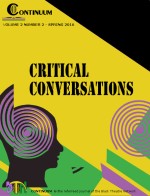solo/black/woman: scripts, interviews, and essays. Edited by E. Patrick Johnson and Ramón H. Rivera-Servera.
Evanston, Illinois: Northwestern University Press, 2014; pp. 367.
solo/black/woman is an anthology of seven solo performance pieces devised and performed by black women—Sharon Bridgforth, Edris Cooper-Anifowoshe, Nancy Cheryll Davis-Bellamy, Misty DeBerry, Rhodessa Jones, Robbie McCauley, and Stacey Karen Robinson. In the Foreword, D. Soyini Madison rightly asserts that “[s]olo black women (SBW) complicate the redundancy of performativity and the talk about it through black female stylizations that are not contingent upon natural repetitions, but on the unnaturalized, resistant, Africanist, gestural economies across black female circumAtlantics” (xiii). Pointing to the nuances and diversity of black feminist and woman-centered drama, Madison concludes that “[t]he gift of SBW is that, inside performance, these black female performativities are not necessarily revealed as naturalized repetitions that shape identity, because their alterity is illuminated and their stylized acts are constantly teasing identity” (xiii). solo/black/woman clearly evinces the significance of U.S. black women’s lives and the performance of those narratives for the performer and the audience.
As the editors E. Patrick Johnson and Ramón H. Rivera-Servera acknowledge in their introduction, "[t]he work of black women performers, playwrights, and critics in the African diaspora represents a diverse and critical component of black arts and letters,” yet their contributions have long been “overshadowed by the work of their male counterparts” (xviii). This anthology reclaims some of that space for black women artists and scholars. In addition to the performance texts, interviews with the artists about their creative processes, intentions and inspiration, and critical essays about the works are also included.
The first section is about Robbie McCauley’s Sugar (2008), a piece about diabetes in the African American community which Sandra L. Richards describes as “interlac[ing] personal stories of coping with diabetes, with memories and interviews of other diabetics, angry disquisitions about disparities in medical treatment, history of the discovery of sugar, and political analysis of connections between the intimately personal and the collective” (27). In an interview, E. Patrick Johnson asks McCauley about the connection between the disease and the traumatic history of slavery, to which she responds: “I can’t say scientifically that there is a connection between slavery and bad health but I don’t think it would take a genius to make that case. The stress around our conditions, the stress not only of slavery, but the trauma and stress of all the ramifications of slavery continue to affect our health, I’m sure” (20). McCauley’s work is significant to her unique experience as a diabetic. It brings public awareness to the disease and encourages dialogue about diabetes within African American communities.
The second section centers on Rhodessa Jones’s Big-Butt Girls, Hard-Headed Women (1989). The characters Jones embodies in her performance piece are based on the lives and stories of incarcerated women she met while working as a fitness instructor in a women’s prison in the 1980s. Lisa Biggs’s “In the Space Between Living and Dying” unpacks Jones’s critiques of black female stereotypes that were pervasive during the Regan era to show how she used her art to “educat[e] audiences about who is really behind bars and what their journey to jail entailed” (73). E. Patrick Johnson interviews Jones and asks her about the importance of ritual in the play. Jones is reflective in her response: “Each one of us deserves to die some sort of natural death. Ritual is made for all the people who did not make it. There were a lot of people, when I started out working the jail cells that didn’t live to make it. They overdosed. They were murdered. Disappeared. So that was one of the reasons. And this theater is holy” (65).
The third section of the book focuses on Nancy Cheryll Davis-Bellamy’s Passing Solo (2007), an adaptation of Nella Larsen’s Passing. In Bryant Keith Alexander’s essay, “Performing Passing and Passing as Performance”, passing is theorized in terms of the “psychology of performance—the things that motivate how people think and how their cosmologies of knowing inform their behaviors; the choices they make, and thus how they live with the consequences and challenges of their actions in everyday life” (113). Alexander argues that passing “is motivated by an intense desire to escape the presumed constraints of blackness” (113). In Jennifer DeVere Brody’s interview with Davis-Bellamy, she asks about “passing as a social act” as it pertains to her as a performer. Davis-Bellamy’s response speaks to the veracity of Alexander’s theory: “Being very fair, fair enough to pass for white myself has always been a part of my makeup. It’s not something I ever did. I thought about it. You think about these things in terms of, oh, what if I were to be somebody else, or pretend to be somebody else, how could that benefit my career?” (107). Passing Solo extends the conversation of passing (as an embodied social act) for contemporary audiences to engage.
Edris Cooper-Anifowoshe’s Adventures of a Black Girl in Search of Academic Clarity and Inclusion is the focus of the fourth section. The artist’s adventures across cultures—black, white, and otherwise—and the problems that arise when one lives betwixt and between cultures are the foci of the piece. Omi Osun Joni L. Jones conducts the interview with the artist and Renée Alexander-Craft provides the essay, “How Does It Feel To Be A Problem.” Cooper-Anifowoshe performs the constraint, confusion, and isolation that can arise from being a black girl in white cultural spaces. In her body and in those spaces, her very existence is always already a problem. Alexander-Craft observes that, at its core, Adventures reckons with whether or not the struggle for intergration and its promises of equality was worth the effort.
The focus of the fifth section is Sharon Bridgforth’s delta dandi (2007). Working in what Bridgforth and Omi Osun Joni L. Jones theorize as a jazz aesthetic, the piece is categorized as ritual/jazz theater—fusing music, movement, African cosmology, poetry, and spirit. Anita Gonzalez conducts the interview and Stephanie L. Baptiste provides the essay, “Aquanova: Collapsing Time In the Lives of Sharon Bridgforth’s Delta Dandi.” In Bridgforth’s solo piece, gender and sexual queerness are evident in terms of character; African cosmology is epistemological; and cyclical time is normalized. Baptiste describes the play as “[t]he gorgeous nonromanticized soundscape of black experience [that is] localized in the experience of ‘Gurl’ and loosely tells the story of her pushing her way through a lifetime of generations of violence and abuse” (238) so that she may give birth to an emancipated self.
The sixth section is about Stacey Karen Robinson’s Quiet Frenzy (2010) a poetry-infused performance of loss, mourning and life. Diana R. Paulin interviews Robinson. Nadine George-Graves in “The Body, Trauma, and History in Stacey Robinson’s Quiet Frenzy”, determines that the protagonist, LaShonda—who is struggling following the death of her twin sister—is negotiating how to live in her black female body despite losing an integral part of herself. This piece, George-Graves suggests, is about the psychological pain LaShonda experiences, which is directly related to “the long history of black women navigating ways to articulate trauma, be it rape, torture, human trafficking, psychological violence, sexual stigma, or degradation” (310).
The book concludes with Misty DeBerry’s Milkweed (2009), which addresses sexual trauma and survival. In “Witness and the Politics of Readdressing Black Pain and Pleasure: Misty DeBerry’s Milkweed” Francesca Royster writes, “DeBerry explores the ways that the experience of violence is always being processed in the body, that the body’s knowledge must be trusted as we make sense of these experiences, and as we transmogrify them in our healing” (351). The body is key to DeBerry’s performance; it represents the violated black female body which is also a site for potential pleasure. In an interview conducted by Raquel L. Monroe, DeBerry says of the ending that she “wanted to tap into—pleasure—pain—the sometimes ambiguity of engaging in mutually agreed upon sexual activity” (346), which is not often a dialectic of value regarding black women’s sexuality.
solo/black/woman is a diverse and exciting collection of performance texts, interviews, and scholarship which expands and enriches the black theatrical canon, performance studies scholarship, and performance practice in significant ways. An enclosed DVD features videos of each of the performance pieces, an invaluable asset for educators to introduce students to solo black women artists whose work illustrate the complexity of black women’s lives and the variations of black womanhood. solo/black/woman continues the project of recovering and uncovering black women’s narratives and situating them in the bodies of black women.
Kristyl Dawn Tift
PhD candidate in Theatre & Performance Studies, University of Georgia



